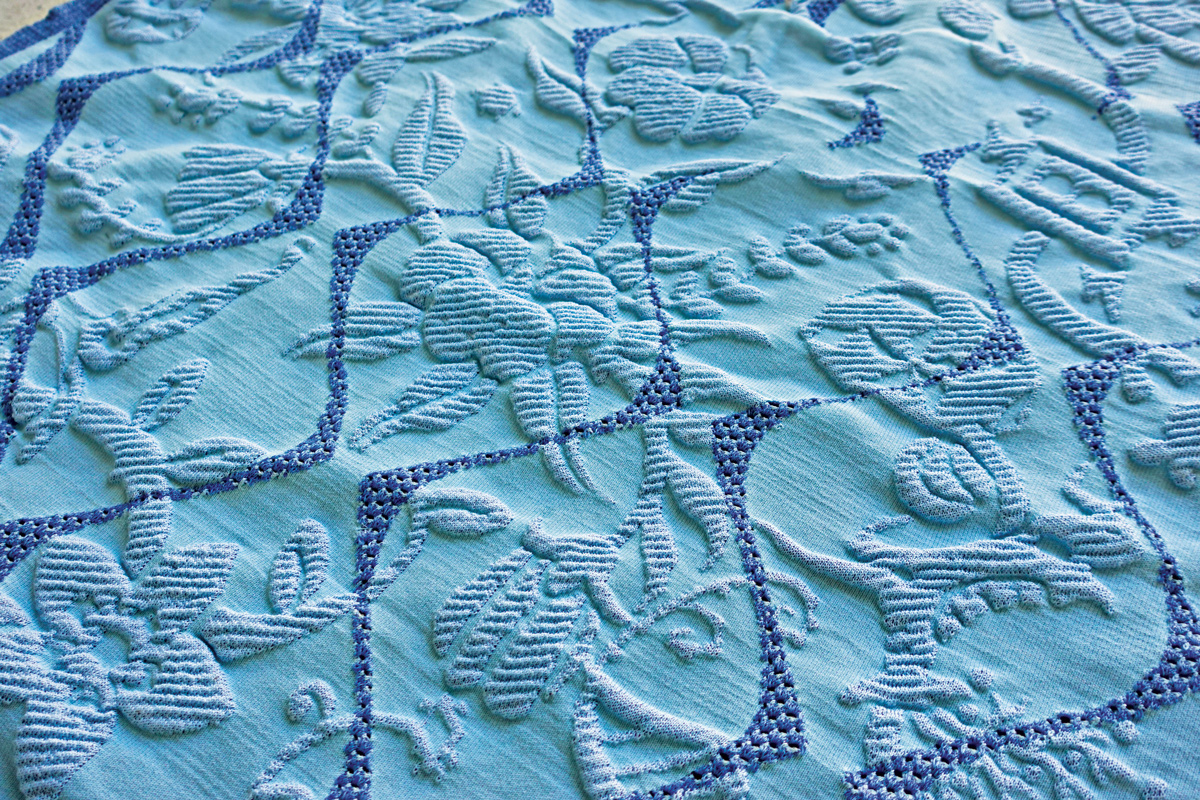
In the summer of 2023, PhD student Irmandy Wicaksono used a weave of recycled polyester yarn and conductive yarn sensors to build the Living Network Pavilion—a large-scale tent structure with lighting and visual patterns that respond in real time to human movement and sunlight—at Burning Man, an annual gathering of innovators and artists held in the Nevada desert.
PHOTO: COURTESY OF IRMANDY WICAKSONO
In the four-week class, she and fellow MIT students partnered with students at the Fashion Institute of Technology in New York City to solve a sustainability problem in clothing manufacturing.
“I was always interested in fashion and in making clothes,” says Chatterjee, who currently works in San Francisco at Refiberd, a company developing intelligent sorting technology for textile-to-textile recycling. “But when I arrived at MIT, it didn’t look like there was a lot going on with textiles. The picture looked very different by the time I graduated.”
“There have always been a lot of exciting ideas in textile research on campus,” says Gregory Rutledge PhD ’90, the Lammot duPont Professor in Chemical Engineering. He leads MIT’s Fabric Innovation Hub, a network of MIT faculty, students, and industry thought leaders created to promote promising ideas and technologies from MIT laboratories that can help revolutionize the textile industry.
“So many great ideas at MIT are born when someone from one department shares their work with someone from another department, but we weren’t doing that in textiles,” Rutledge says. “I realized we needed a way to connect across disciplines, and to identify ourselves for the outside world.”
Surveying the landscape
A loose weave of researchers, students, and textile professionals, the Fabric Innovation Hub has grown organically and gradually. A particularly significant year was 2017, when Maria Zuber, MIT’s vice president for research, appointed Rutledge to coordinate MIT’s engagement with Advanced Functional Fabrics of America as it opened a new prototyping facility just off the MIT campus. “Much of my role was to go around campus to discover what people were doing in this space,” says Rutledge. “To find out who was ready to translate their research into production, and to help find them industry partners.”
Soon afterward, Rutledge and his colleagues built a website to showcase MIT textile researchers and their work, then organized a series of activities and projects both across and beyond campus. Events have included a sustainable footwear summit and a workshop on campus that was coordinated with the joint meeting of the Sustainable Apparel Coalition and the Global Fashion Agenda that took place in Boston in 2023.
Industry-wide challenges
Textiles—the oldest human industry—faces multiple challenges today. Perhaps the most pressing issue is sustainability. Collectively, textile manufacturing produces over four billion metric tons of carbon dioxide equivalent each year, more than the aviation and maritime shipping industries combined. The industry relies on close to 97% virgin feedstock, and it recycles or downcycles less than 15% of its production. The average garment is worn just seven times before it ends up in a landfill.
Researchers in departments across MIT are busy developing technologies to reduce industry carbon emissions. Bradley Olsen ’03, the Alexander and I. Michael Kasser Professor of chemical engineering, and Kristala Prather ’94, the Arthur Dehon Little Professor and head of the Department of Chemical Engineering, are working to identify bio-based monomers for the synthesis of new polyesters that are degradable at the end of the fabric’s lifecycle. In the Department of Mechanical Engineering, principal research scientist Svetlana Boriskina is perfecting a method to make garments from polyethylene.
“The idea was that instead of cooling rooms or buildings, we might try to cool the bodies in those buildings,” says Boriskina, who came to MIT as a postdoctoral researcher in 2012. “For that, we needed a fiber that allowed heat to escape. Polyethylene does that, but it was hydrophobic— it wouldn’t wick moisture. And according to the industry, you couldn’t dye it. We found a way to make it do both. Our environmental analysis of the entire process showed that it had a smaller impact than any other fiber, natural or synthetic.”
From smart wearables to architectural textiles
Part of the Fabric Innovation Hub’s activity is to devise ways to add value to textiles—designing products that people will not readily throw away. One way to do that is through smart textiles, ranging from garments that sense bodily movement and vital signs to drapery that harnesses the energy in sunlight instead of merely blocking it. “If electronics or sensors are becoming more compact, soft, and fiber-like, they can be integrated seamlessly into textiles such as clothing, carpets, interior textiles like curtains and furniture fabrics, or even on a larger scale, as architectural textiles,” says Irmandy Wicaksono SM ’19, a doctoral candidate at the MIT Media Lab.
The human factor
The Fabric Innovation Hub has already yielded viable ideas ready for translation into industry. MIT’s Self-Assembly Lab is collaborating with the MIT-born apparel company Ministry of Supply on a series of smart textiles that change shape and structure in response to heat and moisture. Boriskina works with the US Navy, US Army, medical apparel company Colorchain, and automotive company Seoyon E-Hwa to engineer thermoregulating textile products from the smart polyethylene fiber she developed.
“Our goal is to build a network of knowledge in service of the textile industry,” says Yuly Fuentes-Medel, manager at the Fabric Innovation Hub. Trained as a biochemist at the University of Concepcion in her native Chile, Fuentes-Medel was instrumental in drafting a white paper titled the Footwear Manifesto that outlined strategies to reduce waste in the shoe industry. “We want to support the industry as it faces the challenges of a circular economy, new financial models, and decarbonization. At the Fabric Innovation Hub, we invent, educate, and connect.”
Rutledge believes MIT’s greatest contribution to the textile industry may be its graduates. “Industry can do certain types of research,” he observes. “But we produce smart and educated students for an industry that needs smart and creative people, people who could literally transform the industry. Only an academic institution like ours can do that. I see that when I attend industry conferences. People in the profession know there are problems to solve, and they think that if anyone can solve them, it’s going to be MIT students.”

